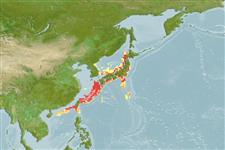Environment: milieu / climate zone / depth range / distribution range
Ecologia
marino batidemersale; oceanodromo (Ref. 51243); distribuzione batimetrica 320 - 830 m (Ref. 54340). Temperate; 46°N - 19°N, 113°E - 143°E (Ref. 54340)
Northwest Pacific: Japan, Korean Peninsula and the East China Sea.
Size / Peso / Age
Maturity: Lm ? range ? - ? cm
Max length : 100.0 cm TL maschio/sesso non determinato; (Ref. 559); Età massima riportata: 8 anni (Ref. 72462)
Short description
Morfologia | Morfometria
Vertebre: 142 - 148. Head and body with white spots. Lower jaw moderate in size, premaxillary teeth not exposed when closed. Upper lip groove deep (appearing folded up). Maxillary teeth arranged in almost 1 row. Preanal lateral line pores 39-43 (Ref. 41299).
Common on coasts of Japan, in sandy-muddy bottoms (also Ref. 11230); most relished among the congrids. Captured and cultured for fishery in Japan.
Life cycle and mating behavior
Maturità | Riproduzione | Deposizione | Uova | Fecundity | Larve
Masuda, H., K. Amaoka, C. Araga, T. Uyeno and T. Yoshino, 1984. The fishes of the Japanese Archipelago. Vol. 1. Tokai University Press, Tokyo, Japan. 437 p. (text). (Ref. 559)
IUCN Red List Status (Ref. 130435)
Threat to humans
Harmless
Human uses
Pesca: elevato interesse commerciale
Informazioni ulteriori
BibliografiaAcquacolturaProfilo di acquacolturaVarietàGeneticaElectrophoresesEreditarietàMalattieElaborazioneNutrientsMass conversion
CollaboratoriImmaginiStamps, Coins Misc.SuoniCiguateraVelocitàModalità di nuotoArea branchialeOtolithsCervelliVista
Strumenti
Special reports
Download XML
Fonti Internet
Estimates based on models
Preferred temperature (Ref.
123201): 0.5 - 13.5, mean 8.8 °C (based on 41 cells).
Phylogenetic diversity index (Ref.
82804): PD
50 = 0.5000 [Uniqueness, from 0.5 = low to 2.0 = high].
Bayesian length-weight: a=0.00058 (0.00036 - 0.00092), b=3.23 (3.10 - 3.36), in cm total length, based on LWR estimates for this species & Genus-body shape (Ref.
93245).
Trophic level (Ref.
69278): 4.0 ±0.68 se; based on food items.
Generation time: 5.8 ( na - na) years. Estimated as median ln(3)/K based on 1
growth studies.
Resilienza (Ref.
120179): Medio, tempo minimo di raddoppiamento della popolazione 1.4 - 4.4 anni (Assuming tm>4).
Prior r = 0.51, 95% CL = 0.33 - 0.76, Based on 1 stock assessment.
Fishing Vulnerability (Ref.
59153): Moderate to high vulnerability (53 of 100).
Climate Vulnerability (Ref.
125649): High to very high vulnerability (73 of 100).
Nutrients (Ref.
124155): Calcium = 23.4 [14.3, 41.7] mg/100g; Iron = 0.299 [0.176, 0.494] mg/100g; Protein = 18.2 [15.4, 21.0] %; Omega3 = 0.6 [0.3, 1.6] g/100g; Selenium = 27.9 [15.5, 51.1] μg/100g; VitaminA = 8.56 [2.37, 30.98] μg/100g; Zinc = 0.377 [0.277, 0.529] mg/100g (wet weight);
